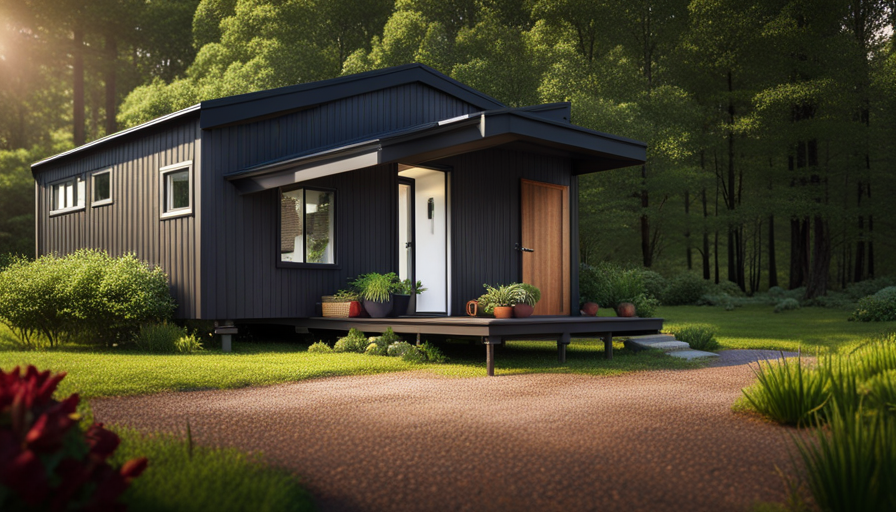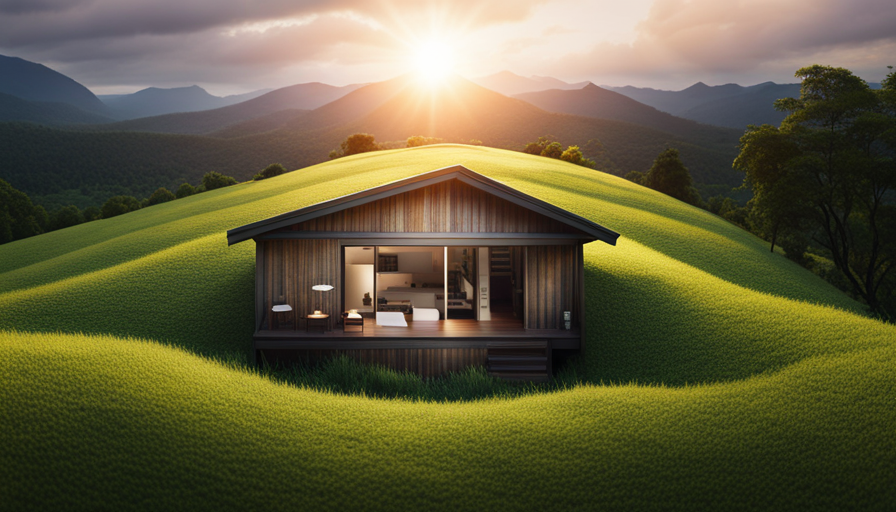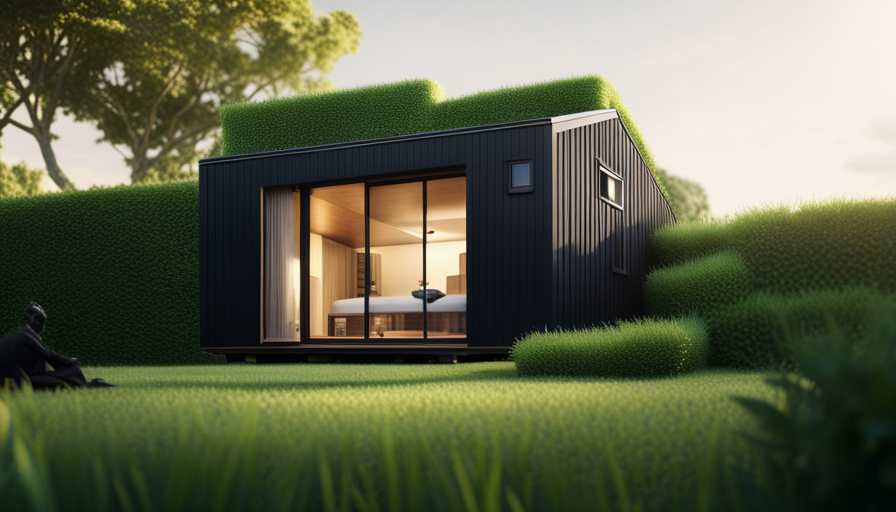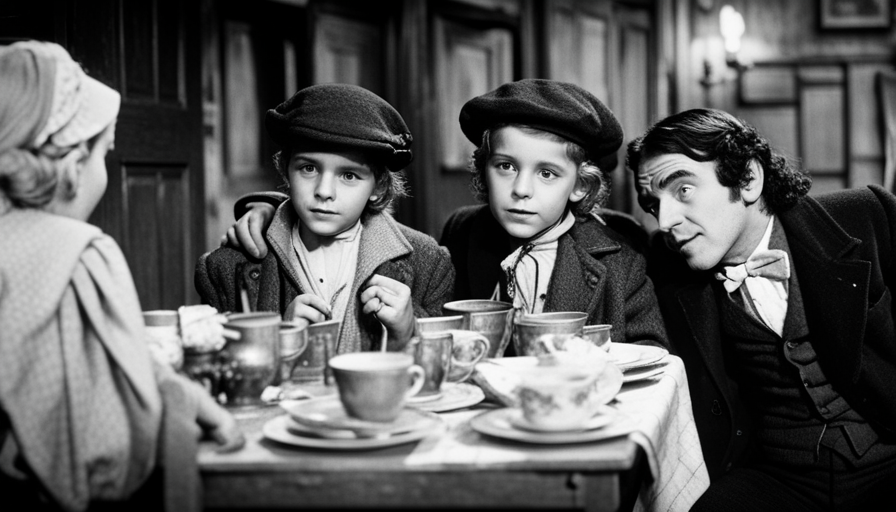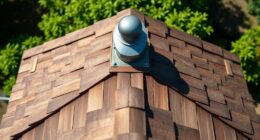Who says old dogs can’t learn new tricks? When it comes to tiny house designs for seniors, it’s not just about learning something new, but also about embracing a whole new way of living. This concept reinvents the idea of downsizing.
It may seem ironic that as we age and become wiser, we find ourselves drawn to the idea of living in a smaller space. But let me tell you, there’s nothing small about the benefits that tiny houses can offer for elderly individuals. From accessibility features and functional layouts to safety considerations and energy efficiency, these homes are designed with the specific needs of older adults in mind.
So, if you’re ready to embark on a new adventure and create a cozy haven for your golden years, buckle up and get ready to explore the world of tiny house living for the elderly.
Key Takeaways
- Tiny houses for the elderly offer accessibility features, functional layouts, safety considerations, and energy efficiency.
- They promote an active lifestyle and increase overall fitness levels, while reducing feelings of loneliness and isolation.
- Customization is important in creating a safe and comfortable living environment for elderly individuals.
- Key features for tiny houses for the elderly include accessibility features, functional layouts, safety considerations, and adaptable furniture and storage solutions.
Benefits of Tiny Houses for the Elderly
Discover the incredible benefits of tiny houses for the elderly, making retirement a dream come true. Tiny houses offer a solution to the social isolation often experienced by seniors. With smaller living spaces, it becomes easier to maintain close relationships with neighbors, fostering a sense of community and reducing feelings of loneliness.
Additionally, these compact homes encourage physical well-being by promoting an active lifestyle. The limited space encourages seniors to move and engage in daily activities, increasing their overall fitness levels.
Moreover, tiny houses can be designed with accessibility in mind, incorporating features such as wider doorways, grab bars, and ramps to accommodate individuals with mobility challenges. These thoughtful design elements facilitate independent living and ensure that the elderly can age in place comfortably.
Transitioning to the next section, let’s explore the accessibility features in tiny house plans, ensuring that every aspect of senior living is taken into account.
Accessibility Features in Tiny House Plans
You can easily incorporate accessible features into these designs, such as grab bars in the bathroom, which can reduce the risk of falls by 80%.
Accessible design is an important consideration when planning a tiny house for the elderly. In addition to grab bars, you can also include widened doorways and hallways to accommodate mobility aids like walkers or wheelchairs. Lever-style door handles and faucets can make it easier for individuals with limited hand strength to open doors and control water flow. Modified appliances, such as front-loading washers and dryers, can eliminate the need for bending or reaching. Installing non-slip flooring throughout the house can provide a safer environment.
When designing a tiny house for the elderly, it’s essential to prioritize accessibility and incorporate these features to ensure a comfortable and safe living space. This will allow individuals to easily navigate the functional layouts without any difficulty.
Functional Layouts for Easy Navigation
To ensure easy navigation within your space, prioritize functional layouts that allow for comfortable and safe movement. When designing a tiny house for elderly residents, consider incorporating ergonomic design principles that optimize ease of movement. Here are some key ideas to keep in mind:
- Open floor plan: Create a spacious layout that eliminates unnecessary obstacles and allows for easy movement between rooms.
- Wide doorways and hallways: Ensure that doorways and hallways are wide enough to accommodate mobility aids such as walkers or wheelchairs.
- One-level living: Consider a single-story layout to eliminate the need to navigate stairs or steps.
- Clear pathways: Keep pathways clear of clutter and ensure that furniture is arranged to provide ample space for easy movement.
- Accessible bathroom: Design a bathroom with grab bars, a walk-in shower, and a raised toilet seat for added safety and convenience.
By incorporating these functional layouts, you can create a tiny house that promotes easy movement and enhances the overall accessibility for elderly residents.
Now, let’s discuss safety considerations for elderly residents without compromising on style.
Safety Considerations for Elderly Residents
Safety is of utmost importance when designing a space for older adults, and incorporating key considerations ensures a secure and comfortable living environment. When planning the layout of a tiny house for the elderly, it is crucial to prioritize emergency preparedness and home security. To help visualize these safety considerations, I have created a table below:
| Safety Considerations | Description |
|---|---|
| Slip-resistant flooring | Install flooring materials that reduce the risk of falls. |
| Adequate lighting | Ensure there is ample lighting in all areas to prevent accidents. |
| Grab bars and handrails | Install grab bars and handrails in bathrooms and along stairways for support. |
| Easy-to-use locks | Use locks that are easy to operate and provide a sense of security. |
| Emergency exit plan | Develop an emergency exit plan and clearly mark escape routes. |
Incorporating these safety measures will help create a secure and comfortable living space for older adults. Moving forward, let’s explore how to incorporate aging-in-place design principles.
Incorporating Aging-in-Place Design Principles
Creating a space that seamlessly accommodates the changing needs and preferences of aging adults is essential for a comfortable and long-lasting home. When designing tiny house plans for elderly residents, it’s crucial to incorporate aging-in-place design principles.
This means integrating features and technologies that promote safety, accessibility, and independence. One key aspect is the use of aging-in-place technology, such as smart home systems that can monitor health conditions and provide assistance when needed.
Additionally, incorporating universal design principles ensures that the space is usable by people of all ages and abilities. This includes features like wider doorways, grab bars in the bathroom, and non-slip flooring.
By considering these factors, the tiny house can provide a safe and functional living environment for elderly residents.
Transitioning into the next section about adaptable furniture and storage solutions, it’s important to also consider the importance of maximizing space and flexibility within the design.
Adaptable Furniture and Storage Solutions
When it comes to designing a tiny house for the elderly, incorporating adaptable furniture and storage solutions is crucial. This allows for maximum flexibility and convenience in a limited space.
Transformable furniture, such as foldable tables and chairs, can easily be adjusted to accommodate different activities and mobility needs. Additionally, utilizing space-saving solutions like wall-mounted shelves and built-in storage units can help maximize the available space while keeping everything organized and easily accessible.
To make the most of the limited space in a tiny house, consider the following:
- Murphy beds: These beds can be folded up against the wall during the day, creating extra living space.
- Multi-functional furniture: Look for pieces that serve multiple purposes, such as a sofa that can also be converted into a bed.
- Built-in storage: Utilize every nook and cranny by incorporating built-in storage solutions, such as under-bed drawers and hidden cabinets.
By incorporating these design elements, a tiny house can provide the necessary functionality and comfort for the elderly.
Now, let’s explore how energy efficiency and sustainability can further enhance the design of tiny houses.
Energy Efficiency and Sustainability in Tiny Houses
To truly enhance your experience and create a sustainable haven, it’s time to delve into the realm of energy efficiency in your compact abode. When designing a tiny house for the elderly, incorporating passive design principles can greatly reduce energy consumption. Features such as well-insulated walls, efficient windows, and proper ventilation can help maintain a comfortable temperature year-round without relying heavily on heating or cooling systems. Additionally, integrating renewable energy sources like solar panels or wind turbines can further reduce reliance on the grid and lower utility costs.
To emphasize the importance of energy efficiency in a tiny house, consider the following table:
| Passive Design Principles | Renewable Energy Sources |
|---|---|
| Insulation | Solar Panels |
| Efficient Windows | Wind Turbines |
| Proper Ventilation |
By prioritizing energy efficiency and sustainability, you can create a tiny house that not only meets the needs of the elderly but also minimizes its environmental impact. Next, let’s explore customizable options to suit individual needs.
Customizable Options to Suit Individual Needs
Enhancing your experience and tailoring your compact abode to suit your individual needs is all about exploring customizable options. When it comes to tiny house plans for the elderly, there are a variety of customization options available to ensure a personalized design that meets your specific requirements.
From adjustable countertops and grab bars to wider doorways and wheelchair ramps, these modifications can greatly enhance accessibility and convenience for elderly homeowners. Additionally, you can choose to incorporate features like handrails, shower seats, and lowered switches to further improve safety and comfort.
By working closely with a professional designer or architect, you can create a space that not only meets your physical needs but also reflects your personal style and preferences.
Moving forward into the next section on financing and cost considerations for elderly homeowners, it’s important to understand the financial implications of these customizable options.
Financing and Cost Considerations for Elderly Homeowners
Creating a personalized and accessible space that meets your unique needs as you age can be a costly endeavor, but the financial implications are worth it for the comfort and peace of mind it brings. When considering financing options for building a tiny house for elderly homeowners, one option to explore is a reverse mortgage. This allows homeowners to convert a portion of their home equity into cash, which can then be used to cover the costs of building or modifying a tiny house.
Additionally, downsizing to a smaller home offers financial benefits such as reduced utility bills, lower property taxes, and decreased maintenance costs. These savings can help offset the initial investment and contribute to long-term financial stability.
With proper planning and financial consideration, creating a tiny house that caters to your specific needs as an elderly homeowner is an achievable goal. Transitioning into the subsequent section about ‘testimonials from elderly individuals living in tiny houses’, these firsthand accounts highlight the positive impact of downsizing and customizing their living spaces.
Testimonials from Elderly Individuals Living in Tiny Houses
Imagine living in a cozy, customized space that perfectly accommodates your needs as you age – these testimonials from elderly individuals in tiny houses will inspire you. Aging gracefully is a goal that many of us have, and tiny houses offer a practical solution for seniors who want to downsize without compromising on comfort.
These testimonials highlight the benefits of living in a tiny house as an elderly person. For starters, the smaller size makes it easier to navigate and maintain. Additionally, the close-knit community that often forms around tiny house villages provides invaluable support and companionship. From shared meals to impromptu gatherings, the sense of belonging and camaraderie is truly heartwarming.
The testimonials also emphasize the importance of customization, as elderly individuals can tailor their tiny houses to meet their unique needs, ensuring a safe and comfortable living environment.
Frequently Asked Questions
How much does it cost to build a tiny house for the elderly?
Building a tiny house for the elderly is like creating a cozy haven that offers independence and comfort. When it comes to cost breakdown, it depends on various factors such as size, materials, and location.
On average, building a tiny house can cost between $20,000 and $100,000. Financing options include personal savings, loans, or even crowdfunding. It’s essential to research and compare different options to ensure a budget-friendly and sustainable project.
What are the most common challenges faced by elderly residents in tiny houses?
The most common challenges faced by elderly residents in tiny houses are related to mobility and accessibility. It is important to make modifications to ensure that the space is easy to navigate and use.
Installing grab bars, ramps, and wider doorways are some common modifications that can greatly improve accessibility. Additionally, incorporating features like lever-style door handles, non-slip flooring, and shower benches can also enhance safety and convenience for elderly residents.
Are there any specific building codes or regulations that need to be followed when constructing a tiny house for elderly individuals?
When constructing a tiny house for elderly individuals, it’s important to consider specific building codes and regulations. Building materials should meet safety standards and be durable. Accessibility features should be incorporated, such as ramps, wider doorways, and grab bars.
It is crucial to follow local building codes regarding the size and dimensions of the structure. Additionally, electrical and plumbing systems should be installed according to regulations for safety and functionality.
Can a tiny house for the elderly be easily modified or expanded in the future if needed?
Yes, a tiny house for the elderly can be easily modified or expanded in the future if needed. The expandability of a tiny house allows for additional living space or features to be added as required. This flexibility ensures that the house can adapt to the changing needs of the elderly.
In terms of mobility features, the tiny house can be designed to include ramps, wider doorways, and grab bars to enhance accessibility and ensure a safe and comfortable living environment.
Are there any government programs or incentives available to help finance the construction of a tiny house for elderly homeowners?
Government assistance and financing options are available to help homeowners construct tiny houses. There are various programs and incentives that can provide financial support, making it easier to build a tiny house. These programs offer grants, loans, and tax credits, allowing elderly homeowners to access the necessary funds.
By taking advantage of government assistance, elderly homeowners can fulfill their dream of owning a small, comfortable home that meets their specific needs and preferences.
Conclusion
In conclusion, as I reflect on the benefits of tiny houses for the elderly, I’m struck by the contrasting combination of practicality and charm that these homes offer.
The functional layouts and accessibility features make navigation effortless, while the incorporation of aging-in-place design principles ensures safety and comfort.
The customizable options allow for personalization to suit individual needs, and the energy efficiency and sustainability aspects promote a greener lifestyle.
With financing options available, it’s clear that tiny houses provide a viable and affordable housing solution for elderly homeowners.
Don’t just take my word for it, listen to the testimonials of elderly individuals who’ve found joy and contentment in their tiny houses.
I’m Theodore, and I love tiny houses. In fact, I’m the author of Tiny House 43, a book about tiny houses that are also tree houses. I think they’re magical places where imaginations can run wild and adventures are just waiting to happen.
While tree houses are often associated with childhood, they can be the perfect adult retreat. They offer a cozy space to relax and unwind, surrounded by nature. And since they’re typically built on stilts or raised platforms, they offer stunning views that traditional homes simply can’t match.
If you’re looking for a unique and romantic getaway, a tree house tiny house might just be the perfect option.
